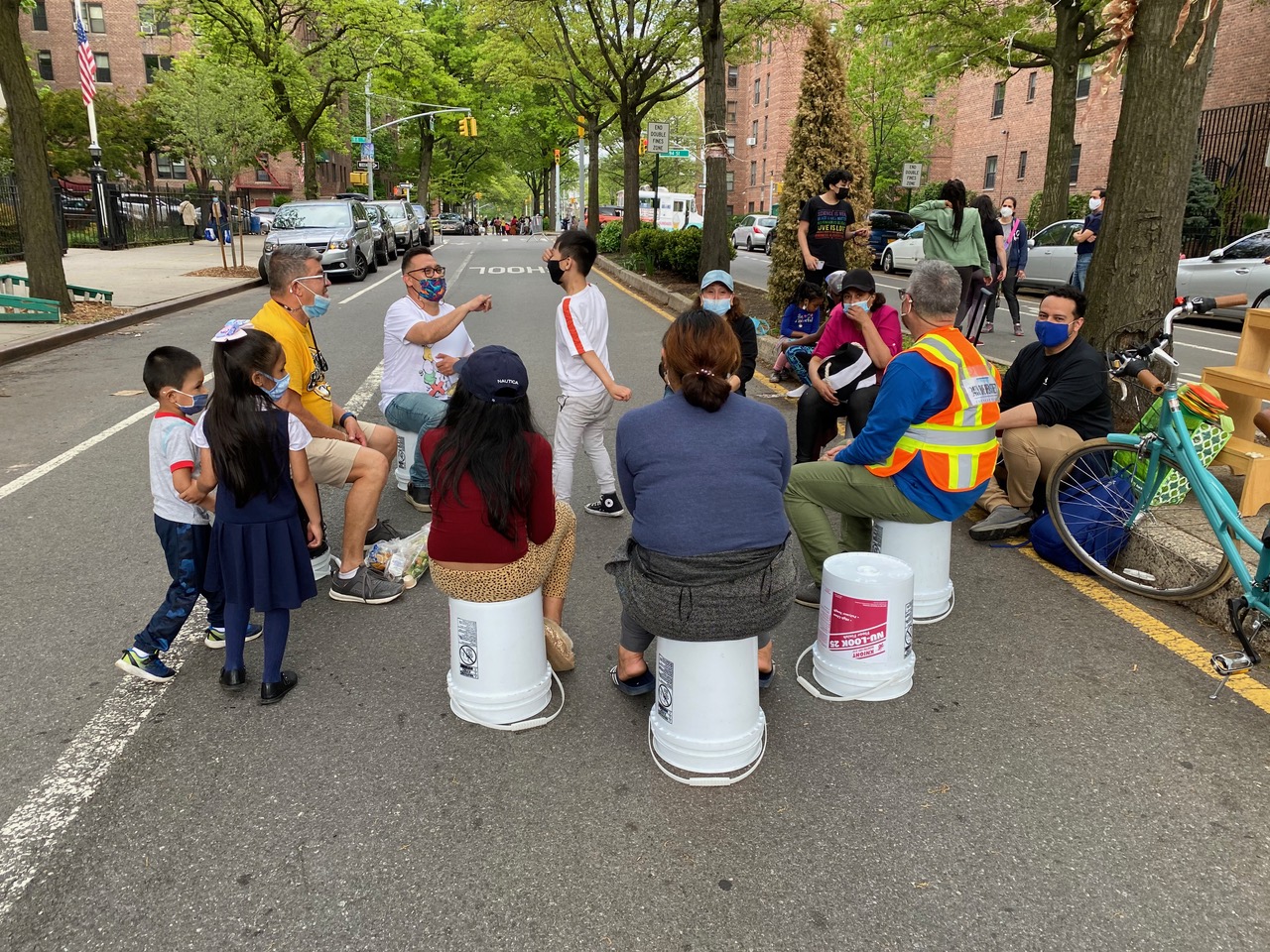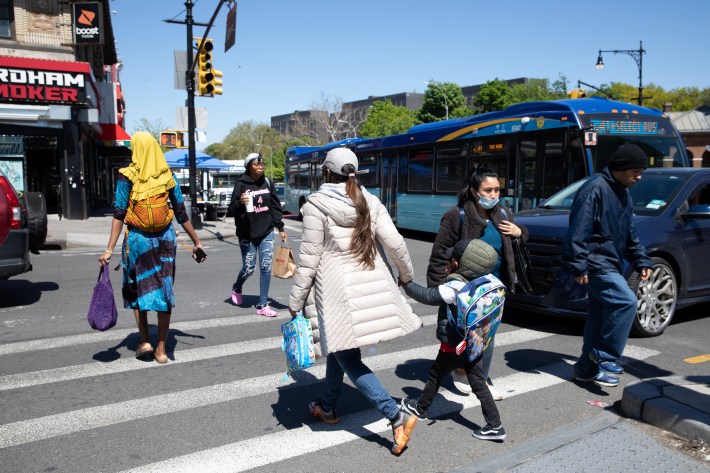‘School Streets’ Program Withering, Parents Blame Lack of City Support
12:01 AM EDT on June 28, 2022

34th Avenue Open Street in Queens. Photo: Clarence Eckerson Jr.
A city program that gives schools outdoor space on neighboring streets is faltering, with fewer and fewer schools participating and those that remain consisting disproportionately of private schools in wealthy neighborhoods, records show.
By mid-June, the Department of Transportation counted just 38 schools taking advantage of its pandemic-era open streets for schools program, which allows schools to bar car traffic on neighboring streets to hold classes, recess or lunch outside or to make student drop-off and pick-up safer.
Those 38 schools are down from the 101 schools that DOT listed as participating in the program in December, and is a tiny fraction of the more than 2,600 schools in New York City. The three dozen are also hardly representative of schools citywide: they are located in Census tracts that on average are far wealthier and whiter than the rest of the city, according to a Streetsblog analysis of Census data. Many are clustered on the Upper East Side, and 39 percent are private or religious schools, which only comprise around 30 percent of all schools in the city, per city and state data.
The DOT blamed the program’s decline on waning interest from schools, noting that they must opt-in to the program, and fewer are doing so.
“There has been a decreased interest among some of these schools, and they are no longer asking for this extra space,” a DOT spokesman said.
But boosters of the program say its unraveling is predictable, given the city provides few resources to participants and requires them to run their school streets themselves, regardless of whether they’re wealthy private academies or cash-strapped public schools.
“It is unsurprising that the inequities that exist across our school system and across our neighborhoods would also exist here,” said Justin Krebs, a Brooklyn parent and supporter of the school streets program. “If open streets are valuable to schools — are valuable to neighborhoods — then we need to provide resources to make sure they’re not reliant on the inherently unequal and uneven and hit-or-miss pillars of volunteerism and charitable donations.”
To run its open street, Grace Church School in Lower Manhattan hired an additional full-time security guard to sit at a barricade at one end of the block, according to Head of School George Davison. The school also bought its own equipment for the street.
“It’s one of the advantages of being an independent school — our procurement is much simpler than a public school,” Davison said. “If I was a public school principal, it would’ve taken a lot longer to get all the stuff that we needed.”
The open street outside P.S. 118 in Brooklyn has not fared as well. School staffers were too busy to take on the added responsibility of running the street, leaving it to parents to volunteer, PTA President Chris Shott said. But it proved harder and harder to find those volunteers, and the school eventually had to abandon the program.
“This is a classic example of parents having to put in a lot of unpaid labor to make up for inadequate funding and resources at NYC public schools — and it’s about to get worse under the mayor’s budget cuts,” Shott said.
City schools will face $215 million in funding cuts under the budget pushed by Mayor Adams and passed by the City Council earlier this month.
DOE spokesman Nathaniel Styer declined to comment and referred questions to DOT.
The lopsided demographics of the school streets program exist despite the frequent statements by Adams and DOT commissioner Ydanis Rodriguez that equity is a guiding principal of DOT's work. Agency spokesman Vin Barone did not respond to a question about those lopsided demographics.
“School-related Open Streets continue to be embraced as a great way to repurpose streets for children to learn and play — as well as to help parents during pick-up and drop-off,” Barone said in a statement. “We strongly encourage schools to apply and work closely with applicants to accommodate their requests.”
Some school administrators noted another possible explanation for the preponderance of private schools with active open streets: many private schools lack dedicated outdoor space, whereas many public schools have their own fenced-in school yards.
Davison said the school-day ban on cars outside Grace Church School has made student arrival and departure much safer, although he said e-bikes zipping down the street still pose a threat.
“It’s not as great a thing as it could be because of the e-bikes, but it is still a huge boon to the safety for the kids,” he said.
But the DOT does not require drivers to remove their cars from streets in use by schools, which some school administrators cited as another shortcoming of the program. One Queens public school staffer, who asked not to be named, said her school decided to stop participating in the program because drivers would frequently move their cars parked on the block when kids were using the open street, making it feel unsafe.
“It’s frustrating because we don’t have any outdoor play space here, which sucks, quite frankly. But without it being like permanent barriers or something, it’s tragically not working,” she said.
Ideally, she said, the street would be fully blocked off to cars.
“That would be beautiful,” she said.
A Streetsblog investigation last month found a large disparity in crash and injury rates on school streets versus other city streets. During the 8 a.m. hour on school days, for example, there are 57 percent more crashes and 25 percent more injuries near schools than in the rest of the city. Crash and injury rate are even higher outside schools with majority poor students and students of color.

Nearly all of the school administrators interviewed by Streetsblog praised the program.
“It’s a lifesaver for us programmatically,” said Bill Holmes, chief operating officer of the Global Community Charter School in Harlem. “Having a dedicated outdoor space adjacent to the school allows our kids to get outside and run around for recess."
Given the program’s benefits, Danny Harris, executive director of Transportation Alternatives, called on the city to provide more support to schools seeking to participate.
“It’s neither appropriate nor fair to put the burden of responsibility on volunteers to manage this, especially when you’re not providing them any kind of financial support,” said Harris, whose group has made a similar assessment of the broader open streets program.
“This is an equity issue, this is a time issue, and it’s not surprising that the schools that have the most resources are the ones that are able to not just build this but sustain it over time," Harris said.
Editor's note: Staff members at five schools told Streetsblog that DOT lists indicating the history of their participation in the program were inaccurate. DOT spokesman Barone attributed the discrepancies to clerical issues.
Jesse Coburn is an investigative reporter at Streetsblog. You can reach him at jesse@streetsblog.org / 917 283 2482.
Read More:
Stay in touch
Sign up for our free newsletter
More from Streetsblog New York City
Thursday’s Headlines: Speed-Limiting Tech Edition
State Sen. Andrew Gounardes continues his push to force reckless drivers to install speed limiters in their cars. Plus more news.
DOT Official: All Our Free Parking Justifies Keeping Curb Space for EVs
If only someone could do something about the parking!
New York City to Install 500 Secure Bike Parking Hubs In The Next Five Years: Sources
Your bike may finally get a roof over its head.
Adams Backs Lower Speed Limits, Calls Crashes ‘Accidents’
The mayor wants New York City drivers to "slow down," but it's not clear yet how many streets will get lower speed limits.
Wednesday’s Headlines: Trump Posts About Congestion Pricing Edition
Donald Trump comments on congestion pricing — no surprise, he's against it. Plus more news.




